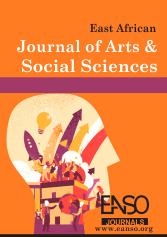Examining the Real-life Application Problems in Welding and Fabrication Students’ Mathematics Exercise Books
Abstract
Vocational education has become the focus of many countries including Ghana because of its economic contribution. One trade area under TVET that is gaining much attention is welding and fabrication because it is used in all aspects of life. Also, welding and fabrication require mathematics competencies. As a result of that, mathematics is taught as part of the welding and fabrication programme in Ghana. The mathematics content taught to welding and fabrication students should be contextualized since it is a professional course. The problem is that TVET students including welding and fabrication students have low interest and do not perform well in mathematics. To address this problem, this study sought to look at the extent to which the mathematics real-life problems in Welding and Fabrication students’ exercise books address the needs of their trade area. The purpose of this study was to examine the extent to which real-life application problems in welding and fabrication students’ mathematics exercise books are related to the trade area. To achieve this, a case study research design under the qualitative research method was employed for the study. Data was collected through the analysis of three welding and fabrication students’ mathematics exercise books. These exercise books covered all the exercises from year one to year three. Data were presented using simple frequency and percentages. The results indicated that only 11.27% of the real-life application problems in welding and fabrication students’ exercise books were related to the applications in the welding and fabrication trade area. It can be concluded that teachers teaching mathematics in welding and fabrication programs pay little attention to real-life mathematics problems in the welding and fabrication trade area. This can affect students’ interest and performance in mathematics thereby equipping them with insufficient mathematics skills required in the welding and fabrication trade area
Downloads
References
American Welders Society (AWS). Fabrication Math I and II. Retrieve on August, 2024 from Fabrication Math I Online Course - AWS and Fabrication Math II Online Course - AWS
Bowen, G. A. (2009). Document analysis as a qualitative research method. Qualitative research journal, 9(2), 27-40.
Choy, S., Wärvik, G. B., & Lindberg, V. (2018). Integration between school and work: Developments, conceptions and applications. Integration of vocational education and training experiences: Purposes, practices and principles, 3-18.
Christidis, M., Hemingstam, A., & Lindberg, V. (2024). Mathematics as an aspect of vocational knowing in animal caregiving, from a student perspective. Learning, Culture and Social Interaction, 45, 100804.
Creswell, J. W., & Creswell, J. D. (2018). Research Design (Qualitative, Quantitative, and Mixed Methods Approaches) (H. Salmon, C. Neve, M. O’Heffernan, D. C. Felts, & A. Marks (eds.); 7th ed.). SAGE Publications Ltd.
Dalby, D., & Noyes, A. (2015). Connecting Mathematics Teaching with Vocational Learning. Adults Learning Mathematics, 10(1), 40-49.
Dueck, M. E., Rafiee, A., Mino, J., Nair, S. G., Kamravaei, S., Pei, L., & Quémerais, B. (2021). Welding fume exposure and health risk assessment in a cohort of apprentice welders. Annals of Work Exposures and Health, 65(7), 775-788.
Fitzmaurice, O., O'Meara, N., & Johnson, P. (2021). Highlighting the Relevance of Mathematics to Secondary School Students--Why and How. European Journal of STEM Education, 6(1), 7.
FitzSimons, G. E. (2014). Commentary on vocational mathematics education: where mathematics education confronts the realities of people’s work. Educational Studies in Mathematics, 86, 291-305.
FitzSimons, G. E., & Boistrup, B, L. (2017). In the workplace mathematics does not announce itself: Towards overcoming the hiatus between mathematics education and work. Educational Studies in Mathematics, 95, 329-349.
Hargiyarto, P., Syauqi, K., Sugiyono, S., Ardian, A., Sianipar, S., & Nadjib, L. A. (2020, December). Analysis of quality student practice results in shielded metal arc welding. In Journal of Physics: Conference Series (Vol. 1700, No. 1, p. 012010). IOP Publishing.
Harris, M. K. (2002). Welding health and safety: a field guide for OEHS professionals. AIHA.
Hodgen, J., Foster, C., Marks, R., & Brown, M. (2018). Evidence for Review of Mathematics Teaching: Improving Mathematics in Key Stages Two and Three: Evidence Review. London: Education Endowment Foundation. The report is available from: https://educationendowmentfoundation.org.uk/evidence- summaries/evidencereviews/improving-mathematics-in-key-stages-two-and-three/
Istas, B., Walkington, C., Leyva, E., & Bernacki, M. L. (2021, July). When Am I (N) ever Going to Use This? How Engineers Use Algebra (NSF DRL). In 2021 ASEE Virtual Annual Conference Content Access.
Lave, J., & Wenger, E. (1991). Situated learning: Legitimate peripheral participation. Cambridge University Press.
Legusov, O., Raby, R. L., Mou, L., Gómez-Gajardo, F., & Zhou, Y. (2022). How community colleges and other TVET institutions contribute to the United Nations sustainable development goals. Journal of Further and Higher Education, 46(1), 89-106.
Leyva, E., Walkington, C., Perera, H., & Bernacki, M. (2022). Making mathematics relevant: An examination of student interest in mathematics, interest in STEM careers, and perceived relevance. International Journal of Research in Undergraduate Mathematics Education, 8(3), 612-641.
Minister of Education (MOE) (2010). Teaching syllabus for welding and fabrication (Technical / Vocational Institutes 1-3).Accra: Ghana.
Muhrman, K. (2022). How can students in vocational education be motivated to learn mathematics? Nordic Journal of Vocational Education and Training, 12(3), 47-70.
Smith, E. (1999). Ten years of competency‐based training: the experience of accredited training providers in Australia. International Journal of Training and Development, 3(2), 106-117.
Vimbelo, S., & Bayaga, A. (2023a). Current Pedagogical Practices Employed by a Technical Vocational Education and Training College’s Mathematics Lecturers. South African Journal of Higher Education, 37(4), 305-321.
Vimbelo, S., & Bayaga, A. (2023b). Humanising Pedagogy in Mathematics Education at South African Technical and Vocational Education and Training (TVET) Colleges: Influence on TVET Teaching and Learning. International Journal of Learning, Teaching and Educational Research, 22(9), 633-655.
Walkington, C., & Bernacki, M. L. (2019). Personalizing algebra to students’ individual interests in an intelligent tutoring system: Moderators of Impact. International Journal of Artificial Intelligence in Education, 29, 58-88.
Copyright (c) 2025 Philip Adjei Acheampong, Francis Kwadwo Awuah, PhD

This work is licensed under a Creative Commons Attribution 4.0 International License.




























